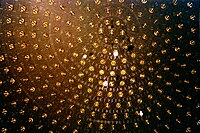
Photo from wikipedia
High-energy neutrinos with energies above a few 1016 eV can be measured efficiently with in-ice radio detectors which complement optical detectors such as IceCube at higher energies. Several pilot arrays… Click to show full abstract
High-energy neutrinos with energies above a few 1016 eV can be measured efficiently with in-ice radio detectors which complement optical detectors such as IceCube at higher energies. Several pilot arrays explore the radio technology successfully in Antarctica. Because of the low flux and interaction cross-section of neutrinos it is vital to increase the sensitivity of the radio detector as much as possible. In this manuscript, different approaches to trigger on high-energy neutrinos are systematically studied and optimized. We find that the sensitivity can be improved substantially (by more than 50% between 1017 eV and 1018 eV) by simply restricting the bandwidth in the trigger to frequencies between 80 MHz and 200 MHz instead of the currently used 80 MHz to ∼ 1 GHz bandwidth. We also compare different trigger schemes that are currently being used (a simple amplitude threshold, a high/low threshold trigger and a power-integration trigger) and find that the scheme that performs best depends on the dispersion of the detector. These findings inform the detector design of future Askaryan detectors and can be used to increase the sensitivity to high-energy neutrinos significantly without any additional costs. The findings also apply to the phased array trigger concept.
Journal Title: Journal of Instrumentation
Year Published: 2020
Link to full text (if available)
Share on Social Media: Sign Up to like & get
recommendations!